
|
As the Kushan empire crumbled and fragmented, many new and old kingdoms sprang up into existence around the periphery of the empire. One of these dynasties,
destined to rival the Kushan in size and strength, was that of the Guptas. Starting from a small kingdom in Magadha (modern Bihar) in the late 3rd century, the Gupta empire
grew rapidly under the leadership of Chandragupta I and his son Samudragupta. By the time of Chadragupta II in the late 4th century, the empire included all of northern India
from the Indus to the Brahmaputra and even extended south along the east coast of the peninsula.
The Gupta period is considered the "Golden Age" of classical India. This was a time when great universities flourished in Nalanda and Taxila, and great writers such as the
playwright Kalidasa and great scientists such as the mathematician and astronomer Aryabhatta, who is credited with the concept of zero among his many achievements, helped
create an atmosphere of tremendous creative impulse. Gupta art is regarded as the high point of classical Indian art, and the coinage is equally regarded as among the most
beautiful of ancient India.
According to the Allahabad inscription of Samudragupta, the founder of the dynasty was named simply Gupta (he is normally called Sri Gupta by modern scholars). He was
followed by his son Ghatotkacha, who in turn was succeeded by Chandragupta I, the father of Samudragupta. It was Chandragupta who started to expand the kingdom
significantly, at least partly through his marriage to Kumaradevi, a princess of the powerful Lichchhavi dynasty. The Gupta era of the year 320 CE was probably started by
Chandragupta, perhaps relating to the year of his accession.
Samudragupta acceded to the throne in c. 335 and he was most probably the first Gupta king to issue coins (although this is the subject of some dispute ... more on this in
the discussion on individual coin types). Gupta coinage started out imitating that of the Kushans, but very soon new types were introduced.
|
 |
Sceptre type ("Standard" type) |

|
Samudragupta, gold dinar, c. 335-375 CE
Weight: 7.46 gm, Diameter: 20 mm.
King standing left, sacrificing at altar left and holding the royal sceptre (rājadanda)
Garuda standard at left, Brāhmī legend under arm: Samudra
circular Brāhmī legend around /
Lakshmi enthroned facing, holding cornucopia and diadem,
Brāhmī legend at right: Parākramah
|
 |
This coin is undoubtedly one of the first Gupta coins. A comparison with late Kushan coins, such as those of Shaka
(which can be seen in the Shaka gallery), show a close similarity; it is quite clear that the Samudragupta coin is
derived from Kushan coins, and Shaka might be the actual prototype, as he was mentioned in Samudragupta's Allahabad inscription and must have been his contemporary.
This type is traditionally called the "Standard type," on the assumption that the king was holding a standard. However, it is now clear that the king would never hold his
standard and that the king must be holding the rājadanda, or royal sceptre. Numismatists have continued to call it the "Standard type" out of a sense of tradition
and inertia. Ellen Raven has argued that we should break this bad habit since it causes confusion and misunderstanding about the nature of the coin type, and I agree. It
should be called the "sceptre type."
|

|
Samudragupta, gold dinar, c. 335-375 CE
Weight: 7.62 gm, Diameter: 20 mm.
King standing left, sacrificing at altar left and holding the royal sceptre (rājadanda)
Garuda standard at left, Brāhmī legend under arm: Samudra
circular Brāhmī legend around /
Lakshmi enthroned facing, holding cornucopia and diadem,
Brāhmī legend at right: Parākramah
|
 |
This coin must have been issued later than the first one ... note how the king's dress has acquired a more Indian
look. |

|
Samudragupta, gold dinar, c. 335-375 CE
Weight: 7.49 gm, Diameter: 21 mm.
King standing left, sacrificing at altar left and holding the royal sceptre (rājadanda)
Garuda standard at left, Brāhmī legend under arm: Samudra
circular Brāhmī legend around /
Lakshmi enthroned facing, holding cornucopia and diadem,
Brāhmī legend at right: Parākramah
|
 |
A rare type in which the king has a dagger or short sword in his belt. |
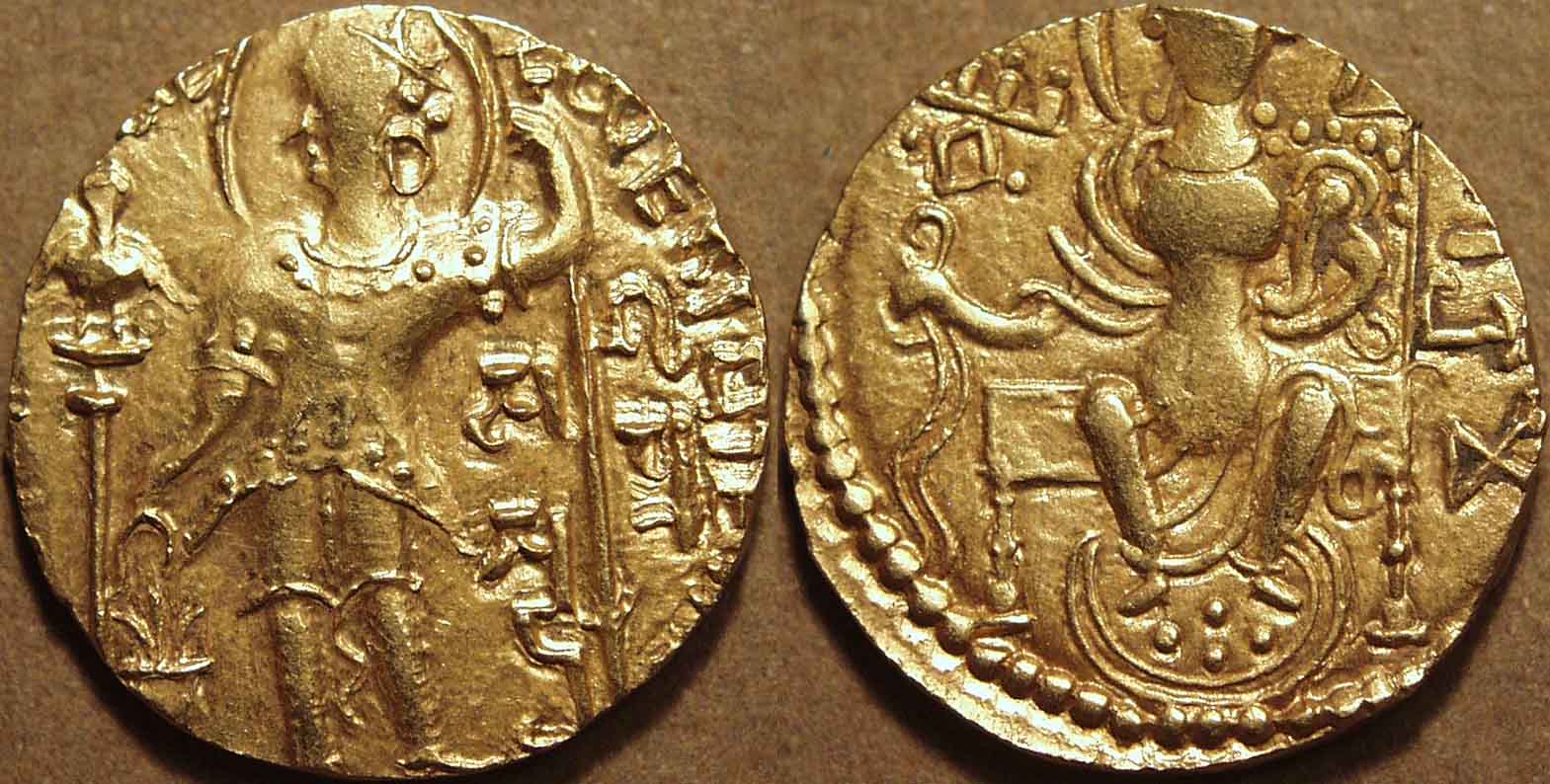
|
Samudragupta, gold dinar, c. 335-375 CE
Weight: 7.64 gm, Diameter: 20 mm.
King standing left, sacrificing at altar left and holding the royal sceptre (rājadanda)
Garuda standard at left, Brāhmī legend under arm: Samudra / gupta
circular Brāhmī legend around /
Lakshmi enthroned facing, holding cornucopia and diadem,
Brāhmī legend at right: Parākramah
|
 |
On this coin, the king's entire name, Samudra / gupta (as opposed to just Samudra) is spelled out in two
vertical arrangements under his arm. |
 |
 |
 |
King and Queen type |
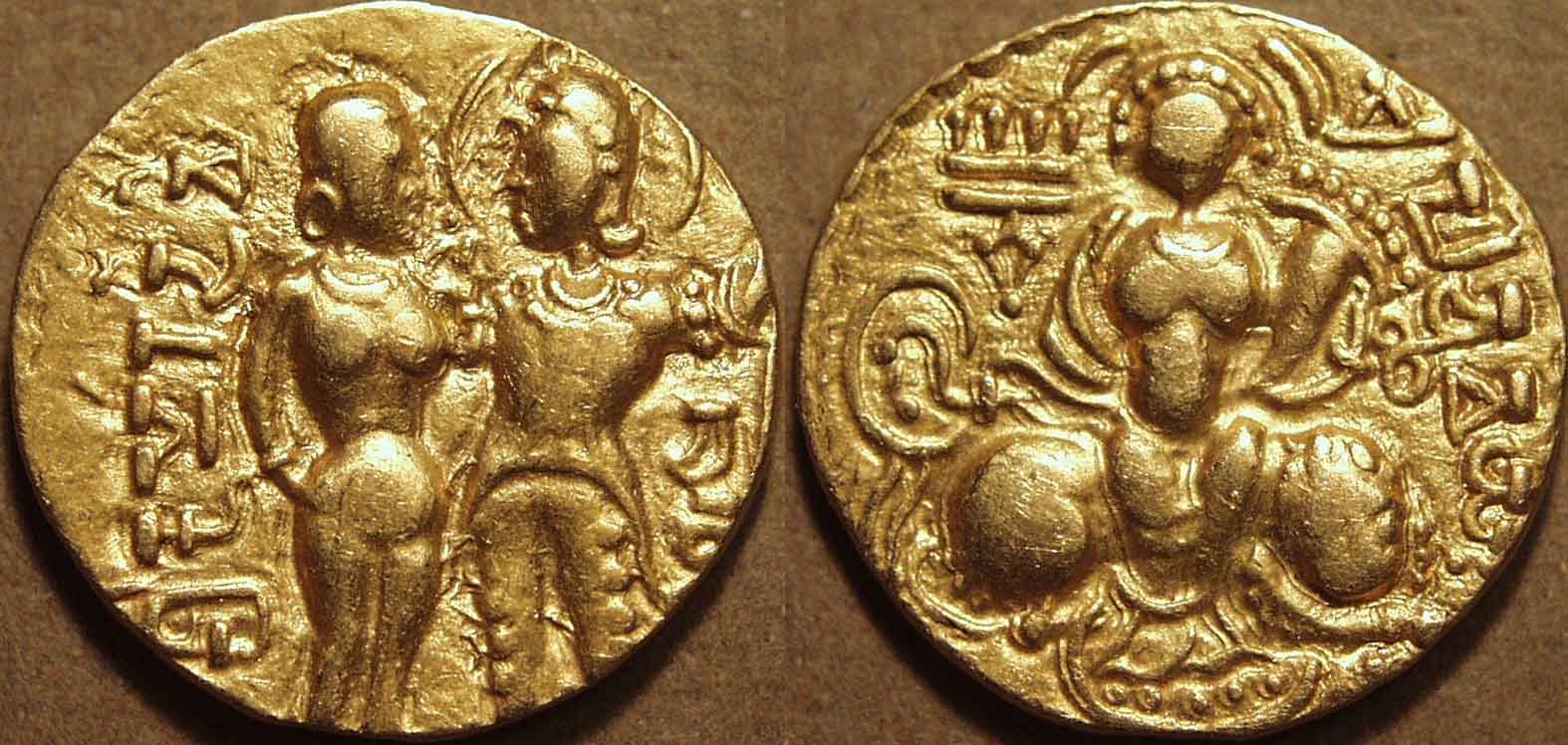
|
Samudragupta, gold dinar, c. 335-375 CE
Weight: 7.44 gm, Diameter: 20 mm.
King standing at right and queen at left, facing each other, king holding up his right hand,
Brāhmī legend at left: Sri Kumaradevi
Brāhmī legend at right: Chandra / (gupta) /
Goddess (Durga?) enthroned facing, seated on recumbent lion right, holding cornucopia and diadem,
Brāhmī legend at right: Lichchhavayah
|
 |
The King and Queen type memorializes the most important event of early Gupta history: the marriage of
Chandragupta I to the Lichchavi princess Kumaradevi. This marriage greatly improved the fortunes of the young and ambitious king, allowing him to begin his campaign
of expansion.
The attribution of the King and Queen type has been the subject of some debate, Allan, in his catalogue of Gupta
coins in the British Museum, assigned them to Samudragupta, while Altekar, in his studies of the Bayana hoard and the corpus of Gupta coins, argued for attributing them
to Chandragupta I. On numismatic grounds, it seems pretty clear that these coins must have been issued by Samudragupta. The clothes worn by the king resemble more
the clothes in the later Sceptre type coins of Samudragupta (see the second through the fourth coins above) rather than the fully Kushan style clothes in the earliest
Sceptre type coins, such as the first coin above. Thus the coins are telling us that the King and Queen coins were issued after the earliest coins of Samudragupta.
On the coins, the king has his right hand raised up close to the queen's face, and numismatists have been wondering what is transpiring between them. Various
suggestions have been made, such as that he is holding up an object or applying sindhoor to her forehead. To me, considering the position of his hand near her
mouth, it seems most likely that he is offering her something to eat. Feeding the bride is an important component of the wedding ritual and I can remember my father
always offering the first morsel of his dinner to my mother ... a daily reaffirmation of his marriage vows. |
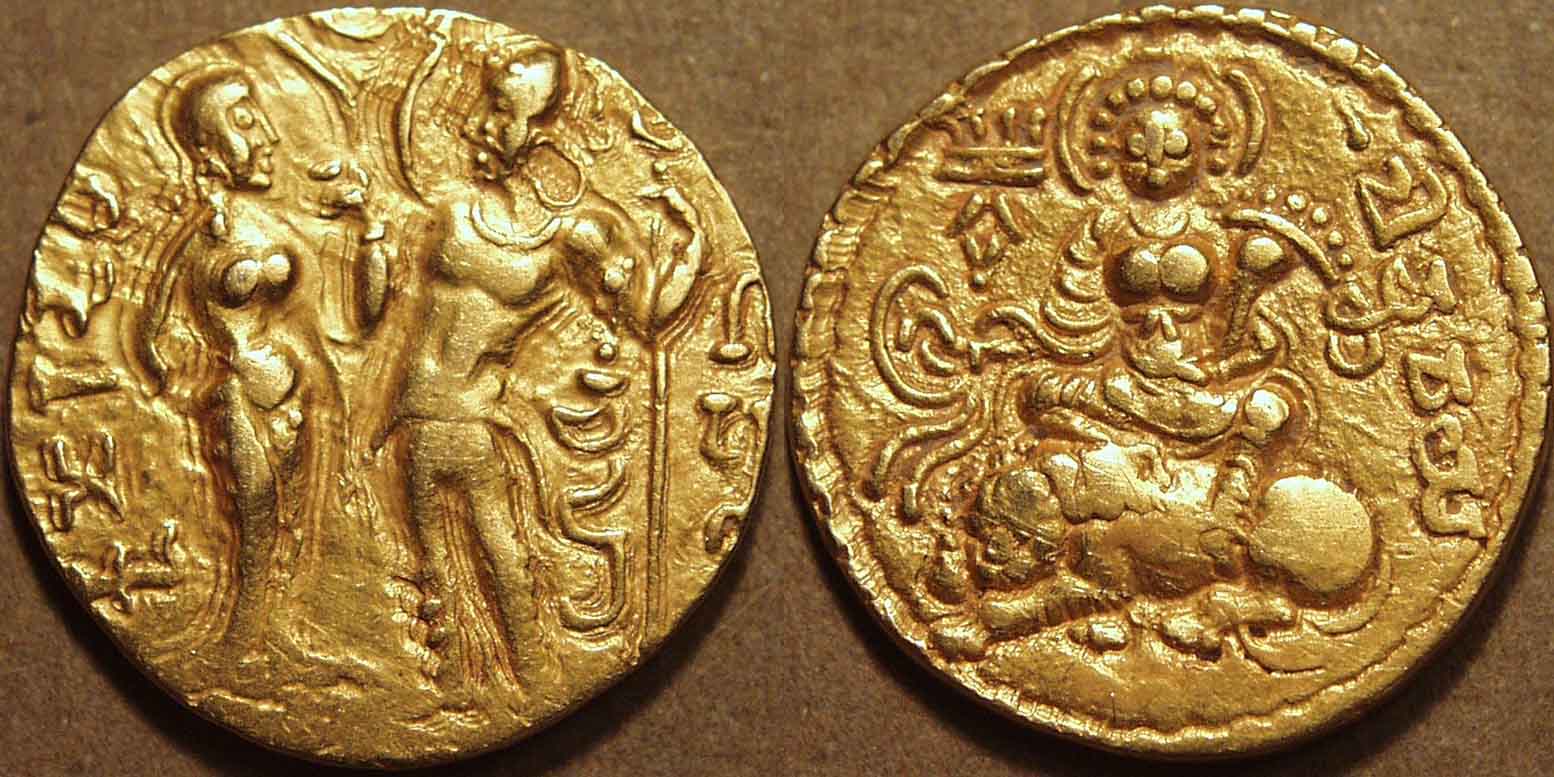
|
Samudragupta, gold dinar, c. 335-375 CE
Weight: 7.50 gm, Diameter: 20 mm.
King standing at right and queen at left, facing each other, king holding up his right hand,
Brāhmī legend at left: Sri Kumaradevi
Brāhmī legend at right: Chandra / gupta /
Goddess (Durga?) enthroned facing, seated on recumbent lion left, holding cornucopia and diadem,
Brāhmī legend at right: Lichchhavayah
|
 |
On this specimen, the lion on which the Goddess is seated faces to the left. Also, the previous coin showed
clearly the legend at the left of the obverse; this coin shows the legend at the right. |
 |
 |
 |
Archer type |

|
Samudragupta, gold dinar, c. 335-375 CE
Weight: 7.15 gm, Diameter: 20 mm.
King standing left, holding an Indian long bow in his left hand and an arrow in his right
Garuda standard at left, Brāhmī legend under arm: Samudra
circular Brāhmī legend around /
Lakshmi enthroned facing, holding cornucopia and diadem,
Brāhmī legend at right: Apratirathah
|
 |
The archer type became the prototypical Gupta coin, but it is relatively rare for Samudragupta, even though he
invented the type. |
 |
 |
 |
Battle axe type |

|
Samudragupta, gold dinar, c. 335-375 CE
Weight: 7.27 gm, Diameter: 19 mm.
King standing left, holding a battle axe in his left hand, right hand on hip
Attendant at left, facing right and holding crescent-topped standard
Brāhmī legend under arm: Samudra
circular Brāhmī legend around /
Lakshmi enthroned facing, holding cornucopia and diadem,
Brāhmī legend at right: Kritantaparashu
|

|
Samudragupta, gold dinar, c. 335-375 CE
Weight: 7.61 gm, Diameter: 20 mm.
King standing left, holding a battle axe in his left hand, right hand on hip
Attendant at left, facing right and holding crescent-topped standard
Brāhmī legend under arm: Kri
circular Brāhmī legend around /
Lakshmi enthroned facing, holding cornucopia and diadem,
Brāhmī legend at right: Kritantaparashu
|
 |
This variety has the letter Kri (presumably for Kritanta) under the king's arm.
|
 |
 |
 |
Ashvamedha (horse sacrifice) type |

|
Samudragupta, gold dinar, c. 335-375 CE
Weight: 7.46 gm, Diameter: 21 mm.
Sacrificial horse standing left, yupa (sacrificial post) before,
circular Brāhmī legend around and si (for siddham) below horse /
Queen standing left, holding towel in left hand, flywhisk in right over her shoulder
needle before, Brāhmī legend at right: Ashvamedhaparākrama
|
 |
The Ashvamedha type of Samudragupta is arguably the most beautiful Gupta coin.
|

|
Samudragupta, gold dinar, c. 335-375 CE
Weight: 7.37 gm, Diameter: 23 mm.
Sacrificial horse standing left, yupa (sacrificial post) before,
circular Brāhmī legend around and si (for siddham) below horse /
Queen standing left, holding towel in left hand, flywhisk in right over her shoulder
needle before, Brāhmī legend at right: Hayamedhaparākrama
|
 |
A unique coin in which the reverse legend reads Hayamedhaparākrama
instead of the usual Ashvamedhaparākrama. Haya is another Sanskrit word that means "horse."
|
 |
 |
 |
Lyrist type |
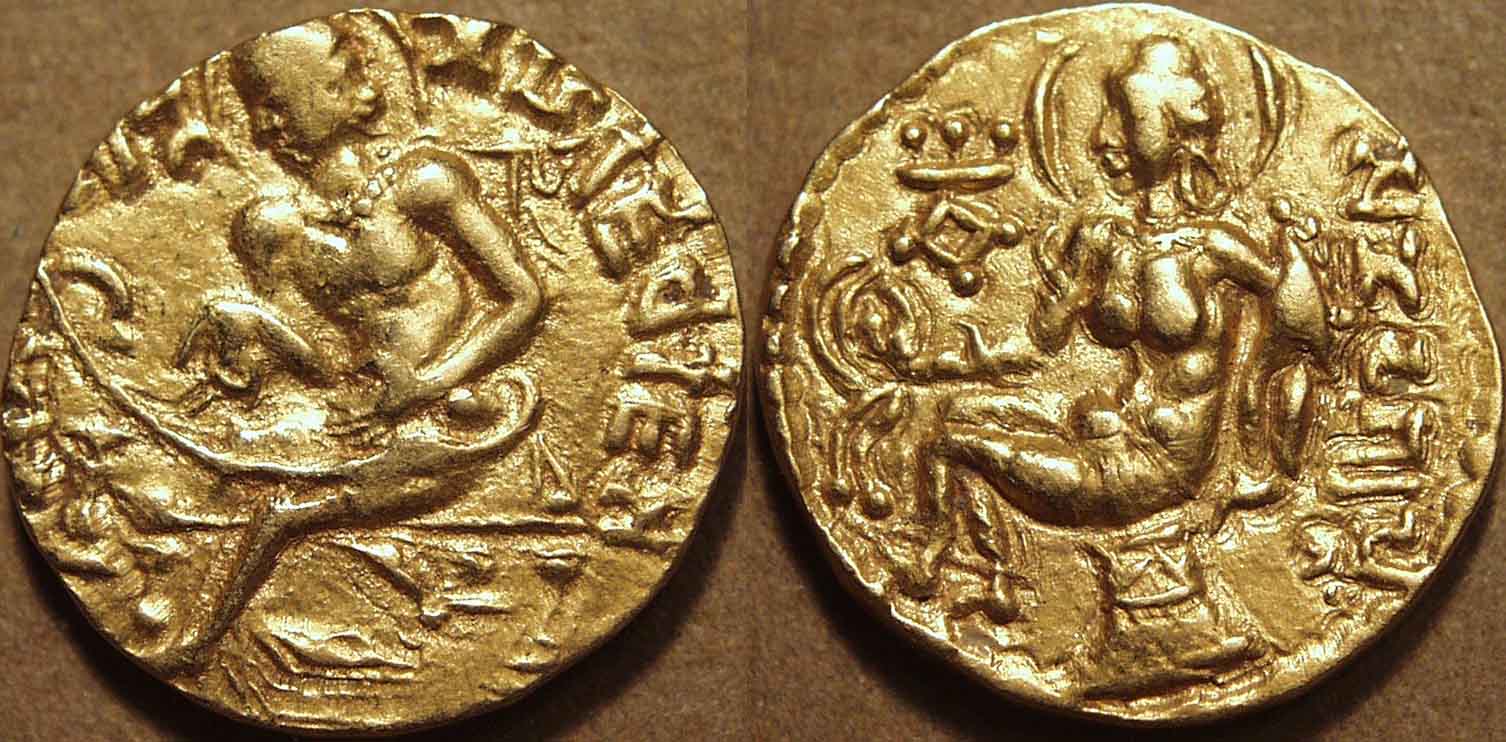
|
Samudragupta, gold dinar, c. 335-375 CE
Weight: 7.85 gm, Diameter: 20 mm.
King seated left on a couch, playing the vina
circular Brāhmī legend around /
Lakshmi seated left on a stool, holding a cornucopia and diadem,
Brāhmī legend at right: Samudraguptah
|
 |
The Lyrist type of Samudragupta is also a very beautiful and unique design. On this coin, the king
is shown seated at ease on a high-backed couch, playing a string instrument like a simple lyre or lute. The fact that the king wanted to publicize an image
of himself as a musician is remarkable and a window into the value system of the Gupta state. Samudragupta is known to have been a great patron of
the arts and was indeed an accomplished musician and poet.
This variety has a tamgha in front of Lakshmi's face and no letter below the king's couch.
|
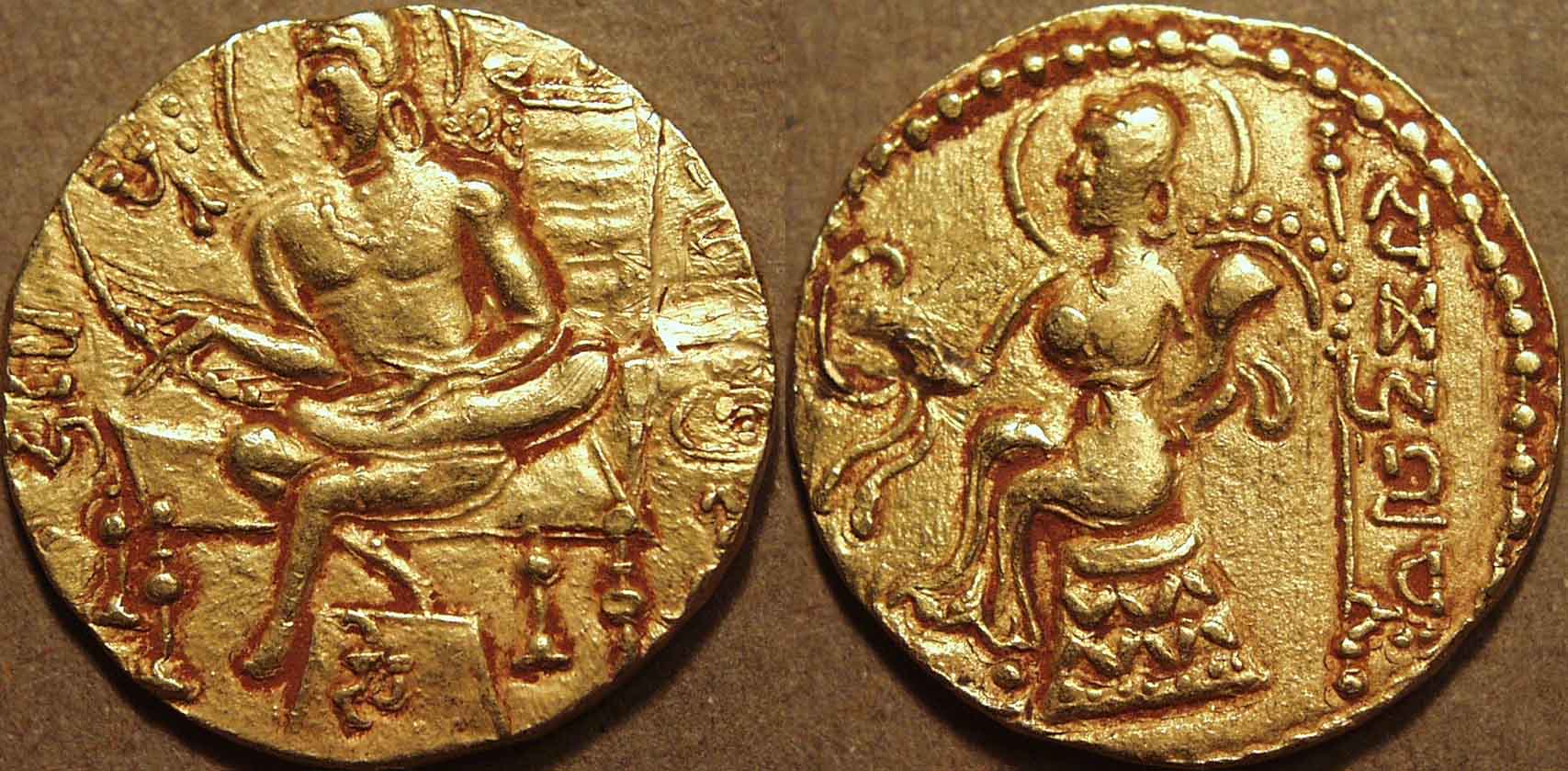
|
Samudragupta, gold dinar, c. 335-375 CE
Weight: 7.68 gm, Diameter: 22 mm.
King seated left on a couch, playing the vina
circular Brāhmī legend around, si below couch /
Lakshmi seated left on a stool, holding a cornucopia and diadem,
Brāhmī legend at right: Samudraguptah |
 |
This variety has no tamgha in front of Lakshmi's face and the letter si (for
siddham) below the king's couch. The back of the couch is also higher and the overall style more beautiful.
|

|
Samudragupta, gold dinar, c. 335-375 CE
Weight: 7.62 gm, Diameter: 22 mm.
King seated left on a couch, playing the vina
circular Brāhmī legend around, si below couch /
Lakshmi seated left on a stool, holding a cornucopia and diadem,
Brāhmī legend at right: Samudraguptah |
 |
Tiger-slayer type |

|
Samudragupta, gold dinar, c. 335-375 CE
Weight: 7.58 gm, Diameter: 21 mm.
King standing left, shooting arrow at tiger at left,
circular Brāhmī legend at right: Vyaghraparākrama /
Goddess Ganga standing left on makara, holding long-stemmed lotus in left hand,
right hand outstretched, crescent-topped standard at left,
Brāhmī legend at right: Raja Samudraguptah
|
 |
Another entirely new type ccreated by Samudragupta's celators, the tiger-slayer type
presumably aimed at show-casing the king's prowess at arms.
|
 |
 |
 |
Kācha type |
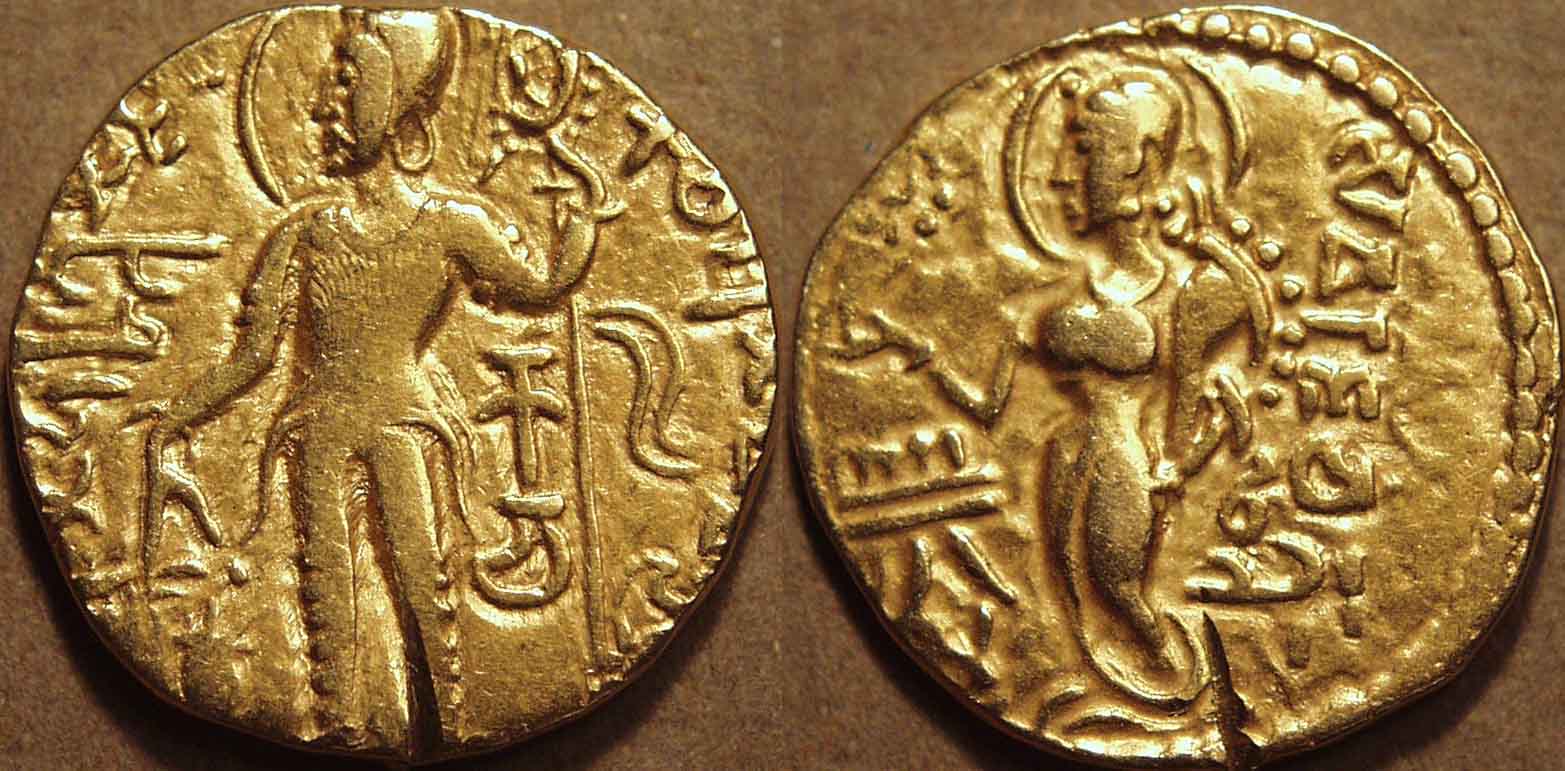
|
Samudragupta, gold dinar, c. 335-375 CE
Weight: 7.32 gm, Diameter: 20 mm.
King standing left, sacrificing at altar left and holding a chakra-topped standard
no Garuda standard at left, Brāhmī legend under arm: Kācha
circular Brāhmī legend around /
Lakshmi standing left, holding cornucopia in left arm and lotus flower in right hand,
Brāhmī legend at right: Sarvarājochchhettā
|
 |
There is some uncertainty about whether the Kācha type coins were issued
by Samudragupta or by some other king. Altekar ultimately concluded that the coins were issued by a king named Kāchagupta.
However, we have no record of any such king, and the epithet Sarvarājochchhettā was in fact applied to Samudragupta in
some inscriptions. Therefore, it seems more likely to me that these coins were Samudragupta issues.
|
|
|